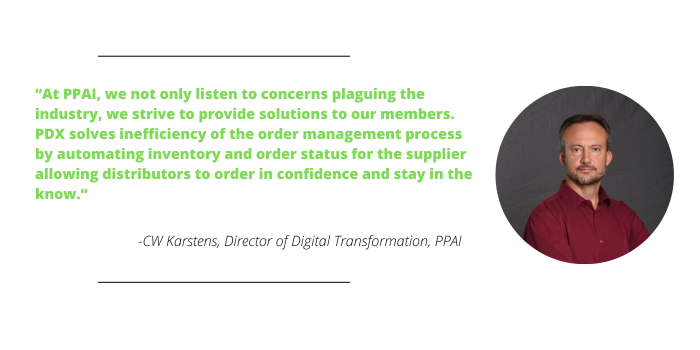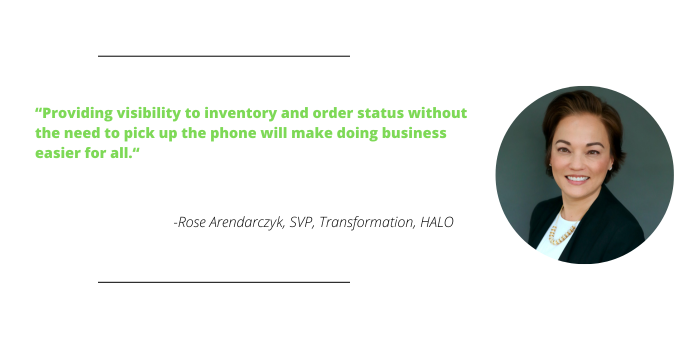In Conversation: Distributors Discuss PDX Needs

Most of the promo world would agree that the industry has an inefficiency problem, and Promo Data eXchange (PDX) is here to solve it.
- PDX is the formula behind PPAI’s mission – in collaboration with SAGE – to eliminate unnecessary phone calls and emails.
“Together we will provide better service to everyone, and ultimately the buying client,” says Dale Denham, MAS+, president and CEO of PPAI. “At the same time, we’ll waste less money and enjoy the work more.”
As more suppliers integrate with PDX, business can potentially become dramatically more efficient for industry distributors.
- In tandem with supplier case studies concerning PDX integration, PPAI Media reached out to three decision makers at leading distributors to discuss the mission of eliminating industry friction.
- Topics include whether they are more likely to work with a supplier that uses an open standard formula and what they envision a more efficient industry looks like.
“At PPAI, we not only listen to concerns plaguing the industry, we strive to provide solutions to our members,” says CW Karstens, PPAI’s director of digital transformation. “PDX solves inefficiency of the order management process by automating inventory and order status for the supplier allowing distributors to order in confidence and stay in the know.”
Thursday, we will publish a case study with suppliers detailing their integration process with PDX.
Below are the results of our PDX distributor conversation.

PPAI Media: One of the primary goals of PDX is to reduce friction in the industry by cutting down or eliminating unnecessary phone calls and emails regarding order status and inventory information. If this goal is accomplished (through PDX or otherwise), do you envision easier processes and faster turnarounds?
Ryan Feignenblatt, Founder & President, The Boca Ratonian: I absolutely envision (and am eager for) easier processes. I see the potential for friction reduction initially in the pre-sale stage, not necessarily once an order reaches production per se. However, over time, the opportunity may arise for suppliers to reinvest savings from increased pre-sale/administrative productivity into production. This, in turn, may reduce production times.
Rose Arendarczyk, SVP of Transformation, HALO: Absolutely. Using technology to improve communications between suppliers and distributors will reduce delays in hand-offs, create more efficiency and improve overall customer satisfaction. Providing visibility to inventory and order status without the need to pick up the phone will make doing business easier for all.
Andrea Krammer, President, City Apparel + Merch: Yes, we only engage with vendors that are on PDX to eliminate costs (time and labor) to process orders and decrease lead time on orders.

Is it important to you to be able to pull inventory and order status information into your ERP system? If so, why?
Feignenblatt: Ideally, yes, since it's one less open tab or phone call, and less room for error.
Arendarczyk: Yes, access to inventory and order status are critical to the order management process. No one wants to place an order blindly. Confirmation and assurance that inventory is available and that the order will be in the customer’s hands when needed is so very important. When there is a delay or issue with an order, the sooner all parties know and can take action, if needed, the better. Having accurate data available in our systems is the best way to stay informed and serve our customers.
Krammer: Absolutely. Inventory and order status are critical to not only process orders but to eliminate order issues while decreasing order lead time.
Are you more likely to work with a supplier who provides that information (via PDX or otherwise) in an efficient way?
Feignenblatt: Yes; if all aspects are otherwise about equal (item/decoration quality, service, inventory, production time, FOB/transit time to destination, price, etc.), priority is granted to suppliers who support their distributor partners with useful data at their fingertips.

Arendarczyk: Distributors handle volumes of orders for our customers and also work with many suppliers across the board. All shapes and sizes. Working with each supplier in a different way can be extremely challenging – and creates an inconsistent experience for promo customers, especially with more complex orders. The more we can standardize and improve the use of technology in our industry, the more consistent and smooth experience we will create for our customers. In addition, reducing friction between suppliers and distributors also reduces costs; a win-win all around that benefits our industry overall.
Krammer: We will only engage with suppliers that provide this information.

What other order process items would be beneficial to you through integration?
Feigenblatt: Current/updated production/proofing times, order entry cutoff times, packaging specs (QTY/carton, weight & dimensions), verified item pricing, run charges, setup fees and any other possible charges (i.e. third-party ship).
Arendarczyk: The entire order lifecycle presents opportunities for technology and supplier-distributor integration. A couple of other areas include purchase orders and invoices.
Krammer: All order status is critical from Inventory, to order, to status, to ship to invoice.

